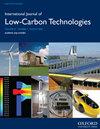利用直接流真空管集热器收集太阳能的简易H2O-LiBr吸收式制冷机的耗能效率
IF 2.3
4区 工程技术
Q3 ENERGY & FUELS
引用次数: 0
摘要
对采用单端玻璃直流式真空管太阳能集热器供电的10kw简单H2O/LiBr吸收系统进行了全面研究。在各种工况下,确定了各系统部件的热工性能系数(COP)和火用性能系数(ECOP)以及火用破坏(ΔE)。在蒸发器温度为1℃、5℃和10℃时,COP分别约为0.75、0.77和0.81,ECOP最大值分别约为0.36、0.35和0.342。在解吸器温度约为90℃时,COP和ECOP值最高。大约41%的系统火用破坏是由于解吸器造成的。对于不同的蒸发器温度,最低的吸收器火用损失发生在解吸器温度为90°C时。将解吸器温度提高两倍,系统效率从0.45降低到0.20。当差温超过50℃时,集热器的效率达到65.88%。本文章由计算机程序翻译,如有差异,请以英文原文为准。
Exergetic-energetic effectiveness of a simple H2O-LiBr absorption chiller operated by solar energy collected using a direct flow evacuated tube collector
A comprehensive examination of a 10-kW simple H2O/LiBr absorption system energized by an evacuated tube solar collector of the single-ended glass direct flow type has been conducted. For various operating conditions, the thermal and exergetic performance coefficients (COP, ECOP respectively), and exergy destruction (ΔE) through each system component are determined. At evaporator temperatures of 1°C, 5°C, and 10°C, COP around 0.75, 0.77, and 0.81, respectively, was achieved, and the maximum ECOP values of approximately 0.36, 0.35, and 0.342, respectively, could be attained. The highest values of COP and ECOP were seen at a desorber temperature of around 90°C. Around 41% of the system’s exergy destructed were attributed to the desorber. The lowest absorber exergy losses occur at a desorber temperature of 90°C for various evaporator temperatures. Increasing the desorber temperature by a factor of two reduces the system’s efficiency from 0.45 to 0.20. In addition, 65.88% solar collector exegetic efficiency was achieved when its differential temperature surpasses 50°C.
求助全文
通过发布文献求助,成功后即可免费获取论文全文。
去求助
来源期刊

International Journal of Low-carbon Technologies
Engineering-Architecture
CiteScore
4.30
自引率
4.30%
发文量
106
审稿时长
27 weeks
期刊介绍:
The International Journal of Low-Carbon Technologies is a quarterly publication concerned with the challenge of climate change and its effects on the built environment and sustainability. The Journal publishes original, quality research papers on issues of climate change, sustainable development and the built environment related to architecture, building services engineering, civil engineering, building engineering, urban design and other disciplines. It features in-depth articles, technical notes, review papers, book reviews and special issues devoted to international conferences. The journal encourages submissions related to interdisciplinary research in the built environment. The journal is available in paper and electronic formats. All articles are peer-reviewed by leading experts in the field.
 求助内容:
求助内容: 应助结果提醒方式:
应助结果提醒方式:


